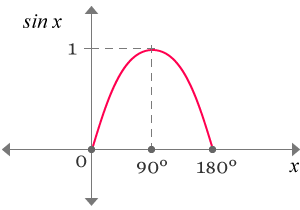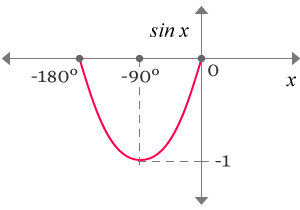A diagram that represents the mathematical relation between the angles and the corresponding values of sine function is called the sine graph.
The values of sine function are repeated for every 360° internal for positive angles. The values of sine function are positive and negative for the positive angles but the sign of values are changed for every 180° degrees interval.

In this region, the values of sine function are positive but it follows two types of patterns.
Sine gives values from 0 to 1 in ascending order from 0° to 90°. It gives same values from 90° to 180° but the values are in descending order.

In this region, the values of sine function are negative and it also follows two types of patterns.
The sine function’s values are decreased from 0 to -1 for the angles from 180° to 270° but its values are increased from -1 to 0 for the angles from 270° to 360°.

Combine both graphs to understand its behavior for the positive angles from 0 to 360 degrees.
It is a graph between angles and respective values of sine function for the angles from 0° to 360°.

The same graph is repeated for every next 360 degrees interval in positive angle region.
The values of sine function are also represented for each 360° internal for negative angles. The values of sine function are also positive and negative for the negative angles but the sign of the values are also changed for each 180° interval.

In this region, the values of sine function are negative but it follows two types of patterns.
The values of sine are decreased from 0 to -1 for the angles from 0° to -90° but increased from -1 to 0 for the angles from -90° to -180°.

In this region, the values of sine function are positive but it also follows two types of patterns.
The values of sine are increased from 0 to 1 for the angles from -180° to -270° but it gives its values from 1 to 0 for the angles from -270° to -360°.
A free math education service for students to learn every math concept easily, for teachers to teach mathematics understandably and for mathematicians to share their maths researching projects.
Copyright © 2012 - 2025 Math Doubts, All Rights Reserved